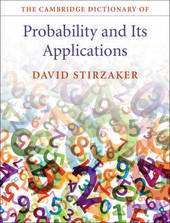
|
The Cambridge Dictionary of Probability and its Applications
Hardback
Main Details
| Title |
The Cambridge Dictionary of Probability and its Applications
|
| Authors and Contributors |
By (author) David Stirzaker
|
| Physical Properties |
| Format:Hardback | | Pages:426 | | Dimensions(mm): Height 253,Width 195 |
|
| Category/Genre | Econometrics
Probability and statistics |
|---|
| ISBN/Barcode |
9781107075160
|
| Classifications | Dewey:519.203 |
|---|
| Audience | | Professional & Vocational | |
|---|
| Illustrations |
80 Line drawings, unspecified
|
|
Publishing Details |
| Publisher |
Cambridge University Press
|
| Imprint |
Cambridge University Press
|
| Publication Date |
10 September 2015 |
| Publication Country |
United Kingdom
|
Description
Probability comes of age with this, the first dictionary of probability and its applications in English, which supplies a guide to the concepts and vocabulary of this rapidly expanding field. Besides the basic theory of probability and random processes, applications covered here include financial and insurance mathematics, operations research (including queueing, reliability, and inventories), decision and game theory, optimization, time series, networks, and communication theory, as well as classic problems and paradoxes. The dictionary is reliable, stable, concise, and cohesive. Each entry provides a rigorous definition, a sketch of the context, and a reference pointing the reader to the wider literature. Judicious use of figures makes complex concepts easier to follow without oversimplifying. As the only dictionary on the market, this will be a guiding reference for all those working in, or learning, probability together with its applications.
Author Biography
David Stirzaker is Associate Professor in the Mathematical Institute at the University of Oxford and an Emeritus Research Fellow at St John's College, Oxford. His previous titles include Probability and Random Processes (with Geoffrey Grimmett, 2001) and Elementary Probability (Cambridge University Press, 2003).
Reviews'To construct a dictionary about such an enormous field is a daunting task, and David Stirzaker deserves high praise, first for even attempting to do so, and second for the success he has achieved. A dictionary's usefulness depends on its organisation as well as on the quality of the individual entries, and this book's structure is simple and logical: two initial pages list the abbreviations and symbols, then the main body of 3000-odd entries with easy-to-use cross-referencing, ending with an appendix of probability distributions ... I shall be delighted to possess this authoritative tome. It will sit alongside Abramowitz and Steguns' Handbook of Mathematical Functions as a reliable source of enlightenment.' John Haigh, University of Sussex
|